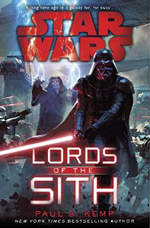
 Dark Disciple: Star Wars
Dark Disciple: Star Wars
By Christie Golden; Foreword by Katie Lucas; Read by Marc Thompson
Publisher: Random House Audio
Publication date: 7 July 2015
[UNABRIDGED] – 11 hours
Themes: / Star Wars / Clone Wars / Sith / bounty hunter / Jedi /
Publisher summary:
The latest story never told in The Clone Wars television saga: A tale of trust, betrayal, love, and evil starring the hugely popular ex Sith/ never Jedi female bounty hunter, Asajj Ventress! A tale written but never aired, now turned into a brand new audiobook with the creative collaboration of the Lucasfilm Story Group and Dave Filoni, Executive Producer and Director of Star Wars: TheClone Wars and Star Wars: Rebels!
When the Jedi decide to target Count DookuDarth Tyranushimself, they turn to his exapprentice, Asajj Ventress, for help in getting close to the slippery Sith Lord. But when unexpected sparks fly between Ventress and Quinlan Vos, the unorthodox Jedi sent to work with her, the mission becomes a web of betrayal, alliances, secrets,and dark plotting that might just be the undoing of both Jedi and Sith and everything in between.
Where did this book come from? I’ve never been much of a prequel person and didn’t get into the Clone Wars TV show but man this book is one of my favorite Star Wars books to date. It has a lot more emotional depth to it than your typical Star Wars book and a lot transpires in such a small novel. Yes it still feels like your typical action pulp novel but with even a bit more. This is the novel that will finally get me to go back and watch the Clone Wars.
The general premise of the book is that the Jedi are concerned about the toll the Clone Wars are taking on the galaxy and decide that taking out the head of the snake will reduce the casualties. That means assassinating Count Dooku. If you can get past the very un-Jedi like premise of this, the ride is worth taking. They decide to send one of their most covert Jedi masters, Quinlan Vos, to team up with Asajj Ventress in going after the Sith Lord. Apparently she decided to become a bounty hunter at some point and he needs to stoke the flames of her hate for Count Dooku so she joins the cause…should be interesting!
The story chronicles everything from concept to courting Ventress (choice wording) all the way to conclusion of things. There are some cameos from the mainstream Star Wars characters but overall this story focuses on Vos and Ventress – which I love. It is a breathe of fresh air to see some other characters take center stage. They have a certain spark for each other and play off one another really well. I think their different backgrounds and their issues add much more of a dynamic to what happens.
We all know how Episode 3 starts but I genuinely did not know where this book was headed. I knew that they couldn’t be the ones who finally did the deed, but wondered if they set up circumstances at the beginning of Episode 3 (I won’t tell you if that happened though). The only reason I bring it up is because I’ve seen reviews of other Star Wars books where people said they almost believed Vader would turn against the Emperor (Lords of the Sith) or that some rebellion could succeed even if you knew it couldn’t because of the movie. I guess this book was that to me where the others were just a fun ride I knew couldn’t succeed.
I wouldn’t say the book is perfect. A lot of things happen in a short period of time or at least I didn’t feel the passage of time as the story progressed. The characters go through a LOT of change in that time and sometimes it felt a bit rushed, but I give Golden credit for pushing for that much change out of them. Other things typical of a pulp novel are here too; like meeting the bad guy and everyone getting away fine.
As for the audio side of things, Marc Thompson did a great job as usual and the sound engineers added all the sound effects and music we’ve come to expect from a Star Wars audiobook. My one minor gripe is that Thompson’s Mace Windu sounds a hell of a lot like Lando Calrissian. That kept throwing me off when the Jedi would convene but apart from that, the audio was great!
Posted by Tom Schreck
 THE BLUMHOUSE BOOK OF NIGHTMARES: The Haunted City
THE BLUMHOUSE BOOK OF NIGHTMARES: The Haunted City  Alive (Generations Trilogy *1)
Alive (Generations Trilogy *1) Puttering About in a Strange Land
Puttering About in a Strange Land Sea of Silver Light (Otherland Book #4)
Sea of Silver Light (Otherland Book #4) Lords of the Sith (Star Wars)
Lords of the Sith (Star Wars)